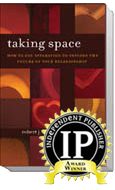 With the high rate of divorce and breakups, marriage and family experts point to the fact that people don’t learn from the mistakes of a failed relationship and assume the next relationship will be better, making little effort to fix or understand what didn’t work.
With the high rate of divorce and breakups, marriage and family experts point to the fact that people don’t learn from the mistakes of a failed relationship and assume the next relationship will be better, making little effort to fix or understand what didn’t work.
There are plenty of self-help books for committed couples on how to enrich a marriage and scores of guidebooks on how to manage through a divorce, but very few focus on partners with differing degrees of commitment where the separation process itself is viewed as an opportunity for self-growth.
Taking Space: How to Use Separations to Explore the Future of Your Relationship provides struggling couples and individuals with a step-by-step process for managing separations. This model allows people to view and use separations as a proactive way to get space, reduce conflict, and focus on self-growth. This method can even work with a non-cooperating partner. This problem-solving road map teaches partners how to design a separation plan that addresses their specific issues by pinpointing 10 essential tasks necessary to maneuver through an often highly stressful experience. The steps are applied through real-life couple situations. Skills, techniques, and coping strategies to empower individuals to overcome feelings of helplessness and victim thinking help create choices where none have been seen previously.
Once partners have the tools and time to manage psychological and/or physical separations, they are often better able to make an informed decision about the future of their relationship. Taking Space helps couples use separation to learn, develop, and then recommit to their relationship with adjusted expectations, perspectives, skills, and a stronger sense of themselves.
For over 30 years, Bob Buchicchio has been working with couples as a marriage and divorce counselor. In the 1970s and 1980s, even as the divorce rate soared and divorce counseling became a specialty of its own, no models existed for counseling couples in the specific issues surrounding separation and divorce. In his practice Bob saw an increasing number of individuals and couples who did not necessarily want to divorce but wanted,or knew they needed, to take space from each other. At the time, taking space was uncharted territory. How could an individual temporarily separate from their relationship or marriage whether emotionally or physically, in the most productive and least hurtful way? Was this a viable alternative to the rush to divorce?
Read more about Robert Buchicchio at www.takingspace.com.
